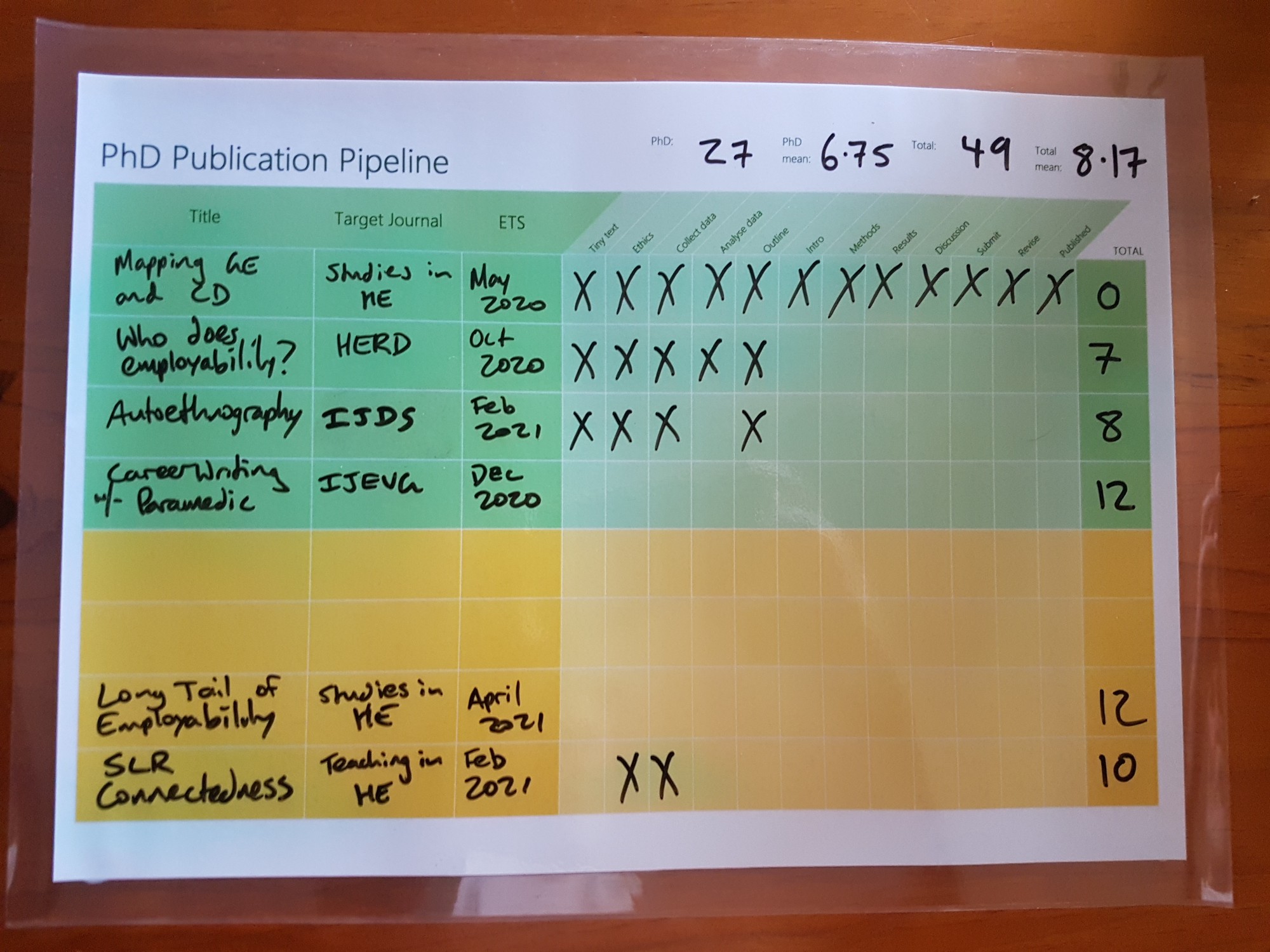Points on the board: How I gamified my PhD by publication progress
There’s a reason why project management is one of the most commonly cited transferable skills from doctoral studies. Keeping track of the various discrete tasks – reading, writing, applications, data collection and analysis, submissions, presentations – would challenge even the most organised candidate. A PhD by publication, in which you work toward a portfolio of published journal articles, has some unique challenges when it comes to planning and organising work.
For the last few months I’ve kept track of my work (and at times, my lack of work), using a simple scoreboard pinned on the wall of my home office. It was inspired by an article by political scientist Matthew J. Lebo, Managing Your Research Pipeline, which I discovered via the inimitable academic productivitist Raul Pacheco-Vega. Lebo was writing for academics working toward tenure, but his system was easily adapted to my PhD by publication, contingent as both goals are on the publication of several articles.

Quite simply, down the left I’ve listed the component articles of my PhD by publication (along with a couple of additional ones), with my first choice of target journals and ( loosely) estimated times of submission. Across the top, I’ve identified 12 milestones in the article writing and publishing process. These stages may not make sense to everyone, but they fit my approach to research and writing well. On the right, I keep a count of how many stages remain for each article, and when I complete a stage, I get the pleasure of writing a big X on the scorecard and reducing the totals accordingly. The conditions of completion for each of these stages are loosely defined; they are done when I am satisfied they are mostly done.
The stages I have used are:
- Tiny text: I have drafted an abstract, following the tiny text approach described by Pat Thomson and Barbara Kamler in their book Writing for Peer Reviewed Journals. For me, I have not really started a writing project until this is done.
- Ethics: I have received ethics approval for my project. Of course, not all projects need this, in which case I enjoy a free bonus point.
- Collect data: I have collected my data, cleaned and organised it, and stored it appropriately.
- Analyse data: I have completed my analysis of the data, exported figures and tables, and written notes to highlight the most important findings.
- Outline: I have sketched out a fat outline of my article, based on an analysis of some exemplars from my target journal, with a target word count and selection of key citations for each section.
- Intro: I have drafted the introduction, literature review, thesis statement and research questions of the article.
- Methods: I have drafted the methods section of the article.
- Results: I have drafted the results section and formatted any tables and figures.
- Discussion: I have drafted the discussion and conclusion of the article, including limitations, application to practice, and future research, as necessary.
- Submit: I have finalised the article draft, formatted the manuscript according to my target journal’s requirements, and submitted it.
- Revise: If invited to revise and resubmit, I have done all necessary revisions, written my response letter, and resubmitted the manuscript. If the article is rejected, I go back to the submit stage and prepare the manuscript for the next target journal.
- Published: The article has been accepted, I have completed all necessary paperwork, and reviewed the author proofs. Job done!
As you can see, I track my total score and mean score, for both just my PhD articles and for all articles. The mean has been particularly useful, because it helps me be very mindful about committing to new writing projects, which require me to add 12 points to my total and inflate my mean score.
One of the most useful aspects of this scoreboard has been helping me get unstuck when my motivation dips or my progress stalls. I find it relatively easy to reorient myself and get started again by asking myself “where can I most easily get my next point from?” This might require me to switch projects, which doesn’t matter much as long as the overall goal – earning my PhD – comes a step or two closer.
If you’d like to create a similar scoreboard, feel free to use my PhD publication pipeline template. It’s designed to be printed at A3 size, ready for you to laminate it, put it up on your office wall, and start getting some points on the board.